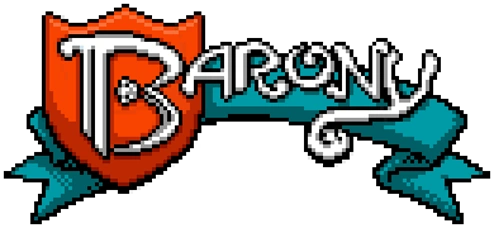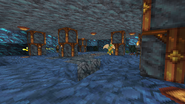- Not to be confused with the group of Tinkering explosives of the same name, Traps (Tinkering).
Traps are a group of hazards elements in Barony, used to disrupt both players and enemies alike by triggering their payloads when activated, often dealing damage or inflicting status effects to those caught in the range of attack.
Description[]
A trap is a static gameplay element, placed around a floor of the dungeon waiting to be sprung upon by the player or an enemy. Each level of the dungeon often introduces a novel type of trap, which is then used for subsequent floors of the dungeon.
This progression of previous traps being used onwards does have some exceptions, notably with some microstructures such as the spider cage in the Mines having spike traps, or the Gnomish Mines having Magic traps in its treasure room. The Citadel also has some notable absences of boulder and arrow traps, preferring to use magic traps, ceiling traps, and rarely spike traps to litter their floors.
Every kind of trap in Barony falls onto a scale of increasing power in proportion to their level of detection and avoidance, with the most lethal traps often having one payload before being rendered useless, while the traps with repeat usage often have their effects be far less intense.
If the player wishes to stop traps randomly generating within the dungeon, there is an option in the Options menu to remove their inclusion in the procedural generation of floors. Some traps are used within microstructures, which are not affected by this option and will still be used with it turned on.
Boulder Trap[]
Introduced as the earliest trap in Barony, the Boulder Trap is first found in the Mines. It is indicated by audio cues similar to the ladder or the sink as well as having a conspicuous open hole above the tile it inhabits.
These traps activate when a player, enemy or item enters their path, which faces one direction and extends from the tile the boulder trap is on to the first wall it comes into contact with. Once activated, the sound of a boulder falling down is heard, and after a brief moment of the boulder touching the floor, it rolls down its path. While rolling, it will break any closed doors, kill most enemies and players, and stops with a thud when it hits a wall.
Players unable to move around the boulder can tank the hit, as a boulder will deal 80 damage on impact, piercing armor. With enough health to survive after the impact, the boulder will be destroyed after coming into contact with an entity with enough health. Alternatively, breaking the boulder as it is coming towards the player is possible with a well timed pickaxe swing or a spell of dig.
Boulders are able to be pushed around by players with five or more points of strength, and are able to be pushed onto enemies for the boulder’s full damage, or pushed into bottomless pits and liquids where they will fall into and are effectively removed from the floor.
There are several unique variants of Boulder traps found through the dungeon, mostly found in the secret areas. The Jungle Temple features some boulder traps which only activate when standing underneath them, the Cockatrice Lair uses several boulder traps which release multiple boulders when flipping switches, and Sokoban uses boulders separate from their traps to create a puzzle system.
Arrow Trap[]
Found naturally generated in the Swamp, Arrow Traps are placed with the walls of a floor, activating whenever anything enters its firing path which extends from each of the tile’s four faces outwards to the first wall it encounters. It is distinguished by having its own tile texture, a gray face made of stone, making it easy to spot alongside an open wall.
Once activated, the trap fires an arrow. In earlier versions of the game, the arrow was always poison tipped, having a chance to inflict poison onto the hit target. As of the Tinkers and Archers 3.3.0 Update, Arrow Traps can now fire any type of arrow naturally found in the game. Arrow traps also have a limited amount of arrows to fire, so they can fire multiple times before emptying, where further activations will be harmless.
These traps can also be lockpicked, with successful attempts relinquishing a quiver of the trap’s arrow type with the remaining arrows inside. Failing to lockpick will cause the trap to fire a retaliatory arrow immediately at the player.
Spike Trap[]
Spike Traps are a series of hidden spikes first found naturally in the Sand Labyrinth, placed onto any normal tile that can be stood upon and activating once something steps or lands on top of it. The trap itself is set low to the ground, with a three-by-three set of holes to signify its presence.
Once activated, the spikes pop out, immediately damaging whatever is on top of it, before quickly retreating back down into its holes. If an entity or item remains on top of a spike trap after it has been detected and pierced, the trap will not activate again until all objects leave its tile.
The biggest threat of Spike traps are its covert nature. Instead of having a distinct texture on a wall at eye-level, they are placed on the floor with holes as an indicator. Combined with sufficient darkness or some of the darker floor textures, and detecting the trap may be difficult.
The trap deals less damage than the Boulder at a modest 50 armor-piercing damage per hit, but can be activated indefinitely, as well as being very effective at taking out party members, who will not avoid these traps when approaching the player.
Magic trap[]
Deep in the dungeon, the Ruins house the Magic trap. This trap is unique to most other types of traps, where it lacks any kind of activator, being inherently activated once the floor is entered.
The trap will fire a bolt of magic from one of its four faces. The order of which face is used is synchronized with all other Magic traps on the floor, where they will all fire from one face, then fire from the next side in a clockwise pattern after a short delay. After firing, the magic bolt will travel nineteen tiles outwards, dissipating upon reaching the end of the nineteenth tile, making the twentieth tile completely safe to stand on.
The type of magic used to fire from the trap appears to be determined at random, even in heavily scripted areas such as the Gnomish Mines, the types of magic used in each trap can vary. Whatever the type of magic, it will be cast in an appropriately colored bolt to how a player or enemy would cast it, so a bolt of forcebolt will be pink, while a bolt of chill will be blue.
Ceiling Trap[]
The last unique trap type found as far as the Caves, the Ceiling Trap is a combination of the Spike Trap and the Magic Trap, having an area of activation on the tile it is situated upon and firing a magic bolt quickly down towards its target. The ground tile has a visible bronze-colored pressure pad, with a similarly colored magic emitter on the ceiling above it.
Unlike its trap counterpart, this trap doesn’t constantly activate unless there is something on the pad below. Once there is something on the pad, it will repeatedly fire its magic onto the tile beneath it. The type of magic is randomized just like the Magic trap.
For both Magic trap and Ceiling Traps, the range of magic that they can be randomly assigned includes:
- Forcebolt
- Confusion
- Magic Missile
- Fireball
- Lightning
- Slow
- Bloodletting*
- Chill
- Sleep
The Cockatrice Lair contains several Ceiling traps that cast Bloodletting, though this spell isn’t used in either magic trap or ceiling traps outside of this secret area.
Gallery[]
Trivia[]
- If a boulder ends up blocking a necessary path for the player, a failsafe will cause it to break into stones as if hit with a pickaxe, with a message in the chat stating: “You sense the gods of Sokoban aiding your path...”
- While most other bolts are properly colored, the Ceiling Traps in the Cockatrice Lair cast green bolts rather than the Bloodletting spell’s unique crimson bolts.








